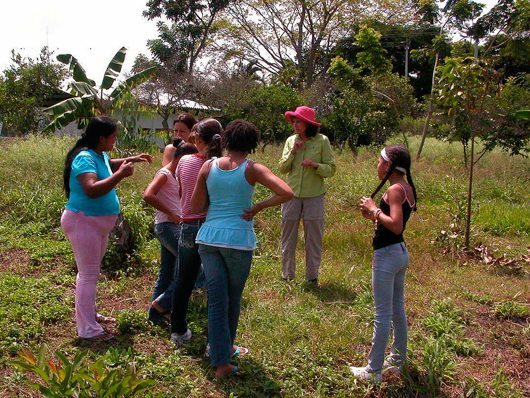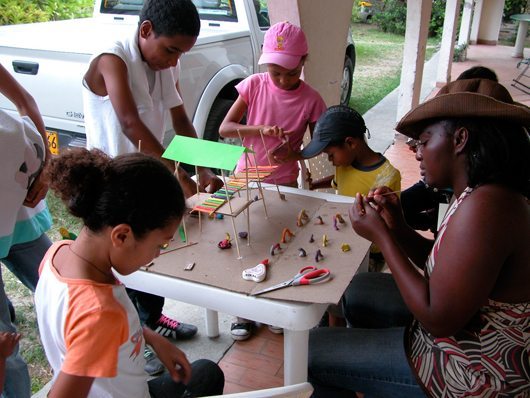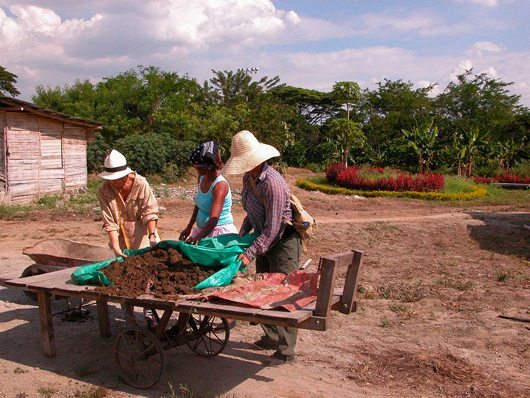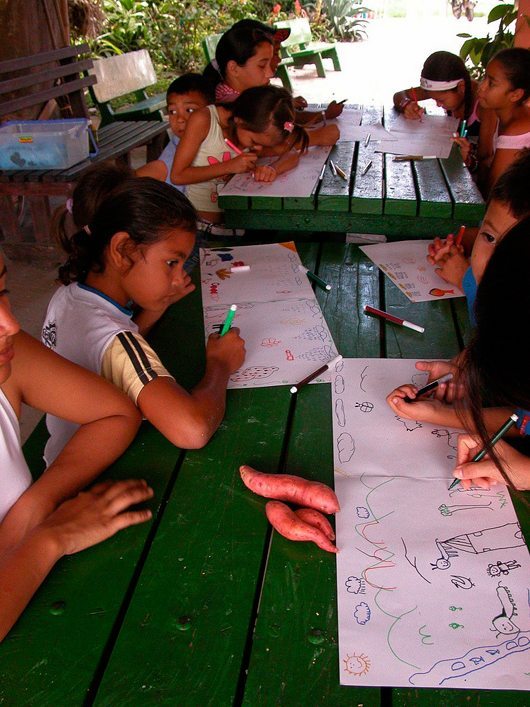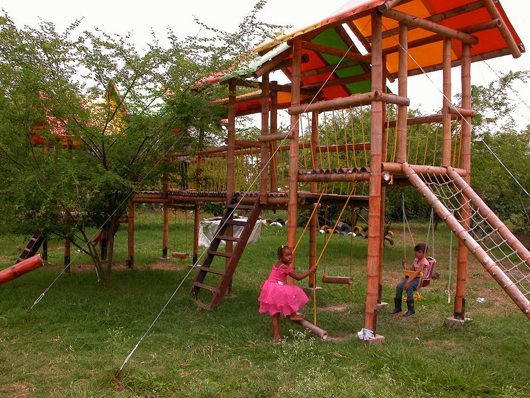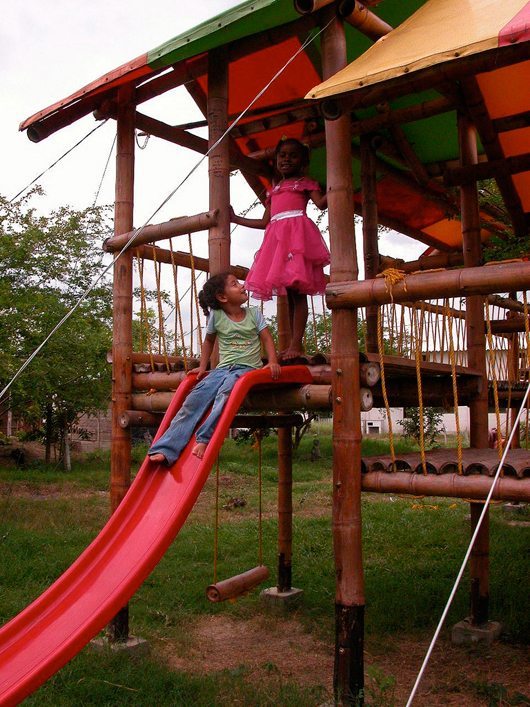Location: Cali, Colombia
EDITOR’S NOTE
Here are two complex reports and a postscript from NASHIRA – a nascent utopian collective eco-village and farm for displaced women who are heads of families. Integral are art projects that hope to empower women and children to envision and create their own environment and future.
PART I THE CURATOR. Born in Sweden, Veronica Wiman has been working as a curator and guest professor in Cali, Colombia, for the past three plus years. Deeply committed to Nashira, she writes an analytical, philosophical introduction to her curatorial project La Vida es Un Teatro.
PART II THE GUEST ARTIST. Wiman invited Oakland CA ecoartist Lauren Elder in 2009 and 2010. Elder shares experiences working with children there to design a butterfly vegetable garden and a playground.
POSTSCRIPT- Conceptual artist Andi Sutton was at Nashira when Lauren Elder was.
PART I: LA VIDA ES UN TEATRO
by Veronica Wiman, Curator
I. COMING TO NASHIRA
Nashira – Un Canto de Amor – is a magical place in a small town, El Bolo on the way to Palmira from Cali, Colombia. To get there, make a right turn at the “Alaska Panaderia.” Continue some meters down the road until the big sign: ‘Eco Aldea Nashira.’ This is the entrance to the eco-village for women who are the heads of families.
Today 200 people live in Nashira. Women with their families have moved into houses they built over the past five years. The infrastructure of this miniature society and community is simple, run by a Board of women who represent eleven labor groups.
II. LA VIDA ES UN TEATRO
La Vida es Un Teatro is a children’s park and education site in the center of Nashira. For the past three years I have been developing, curating and producing community participatory projects (both physical and ephemeral) there. Residents help plan the projects and work along side visiting artists to realize them. Guest artists have included Colombians Helena Producciones, Jaqueline Diaz, Rodrigo Uribe; Americans, Fallen Fruit (Los Angeles) and Lauren Elder (Oakland CA); and from Italy, Nathaniel Katz.
III. THEORETICAL CONCEPTS IN PLAY
Dutch cultural theorist Johan Huizinga (Homo Ludens: A Study of the Play-Element in Culture) wrote, ‘All play means something.’ My vision for Nashira is to use play and recreation as a source for both pleasure and knowledge.
Activities of play are key functions within a culture. A culture, its expression, is most clearly identified in the activities of play that take place within it. Throughout history play has been a signifier for the development of civilization. We are all players, and our play is a significant part of our participation in society. The pleasure and fun implicit in play exist beyond the rational. It has no general concept of language or way of expression beyond actual playing.
According to French philosopher Roger Caillois, play exists in ‘pure space’ away from real life; and in order to grasp its function, one must describe each and every play. La Vida es Un Teatro is hopefully this ‘pure space’ where play is an element in building a culture and civilization in Nashira, and a proposal for a real utopia.
IV. IDEOLOGICAL CONCEPTS AT WORK
As an initiative by ASOMUCAF (Association of Women Heads of Families) and its founder Angela Dolmetsch, the ideology of Nashira is essential to La Vida es Un Teatro.
The land of Nashira is privately owned and donated to the village where the houses are built with support from Palmira Municipality. Each woman head of family owns her house, but it can never be sold, just given to a family member.
La Vida es Un Teatro is an ecological and gender-aware educational playground for children and seniors to come together to share and to comfort each other. The playground for children coexists with the activity and recreation site for Nashira’s elderly citizens.
It supports its own ecosystem, where humans are part of nature. They generate sources of naturally powered energy. Play and activity elements such as bikes, wheels, and water generate power to drive other parts, such as the circulation of a water fountain, lights, etc.
V. EXPERIMENTAL CURATORIAL PHILOSOPHY
Invited artists begin all interventions and constructions in a dialogue with the community to design and plan the process and implementations. The artists and I initiate community participatory parts of the playground or more ephemeral community experiences, but there is no need for us to claim them as artworks. This term almost sounds out of context. It is an experimental curatorial site. By inviting local and international artists, my curatorial ambition is to place their work and practices into this context in search of new experiences and meanings for art.
When these artists’ practices are placed in this real life context, there are many functional challenges, including a dependency of the residents, an everyday community structure, with its practical needs and economic realities, and finally the tropical environment itself.
Western Art terms for this work include community art, public art, or social practice. My goal is to bring these practices into the field to discover the opportunities and challenges. With Latin America as context, part of the project’s ambition is to look for local meanings of those terms. What do they mean here; do they apply at all?
I have had the opportunity to invite several younger artists, graduated from Masters Programs in the US, Norway and Sweden to participate. For them, as others, many personal and cultural concerns arise. I believe this is part of the profound
experience. The radically different reality of life and meaning of artwork is more than overwhelming in this context. I cherish this and feel lucky to give opportunity in Nashira for others to experience.
In my opinion, art students in Western educational institutions appear to have become more privileged and less driven to seek encounters with unknown realities or to be challenged by them. A large part of the challenge that I refer to concerns knowledge about history and heritage, political and cultural oppression and domination. Another basic challenge is on the demanding physical level: tropical weather in the middle of a sugarcane landscape, and ‘Jejen’, small black mosquitoes that sting every part of the body not covered with clothing.
VI. THE POWER OF CRAFT
Craft plays an important role in the practical and conceptual environment of La Vida es Un Teatro. My intention is to emphasize and explore the pedagogical power of Craft as well, as a cultural signifier and bearer of history and present times. We make things with our hands inspired and guided by local ceramists and artists and the rich pre-Colombian earth that Nashira is built on.
Craft is often referred to as “handmade communication.” Women’s conversations while digging soil and chatting as to the uses of herbal plants, or to the shapes and form of the butterfly garden, becomes useful for future creative endeavors.
Some weeks ago we began the work of a long -planned fountain ‘Pachamama Fuente’, designing the patterns and laying out the mosaic. From early Saturday mornings until late afternoons, the elderly group of women in Nashira sit with large sun-hats making patterns of spiritual symbols such as fish, footsteps and a woman’s womb – in the shape and concept of the figure mother earth – Pachamama.
VII. CURATORIAL WORK ON WOMEN’S RIGHTS
La Vida es Un Teatro is a continuation of curatorial work on women, fear and public space that I worked with during my first visit to Colombia in 2007. I continue to explore women’s rights, and ways they may participate in and construct their environment.
Fear and Gender in Public Space, begun in 2003, is based on the idea that “there is a rape park” in almost every city. It is similar to La Vida es Un Teatro in that it is experimental and an ongoing international research, education and curatorial project led by myself in collaboration with students, artists and institutions. I have led a series of academic courses/workshops, exhibitions and interventions in the Art Academy in Helsinki; School of Arts Witswatersrand in Johannesburg; Konstfack School of Art and Design, Stockholm; University of San Francisco; Shristi School of Art and Design, Bangalore. The project investigates theoretical and practical aspects of the interdisciplinary, bringing practitioners from various fields together such as art, architecture, craft and design.
VIII. CONCLUSION
Working and living in Colombia for more than three years has led me to and facilitated unanticipated work and research. Personal and professional interests guided me naturally to explore, learn and advance, influenced by the unexpected. When I decided to set my base here indefinitely, I didn’t necessarily have in mind to force myself into a local working environment. Travel between North and South America, and the encounters along the way have nourished and guided me.
A welcoming local community and my own curiosity and desire to engage was too strong to resist developing an involvement in many directions. The emphasis on research, archives, collective work and educational processes within curatorial projects here is complex and grounded in the many levels of society. I am gratefully learning and growing. I am searching for local meaning and transdisciplinary ideas in social practice, public practice, community art, gender awareness through art practice, radical pedagogy, curatorial practice, different from the ones formed by Western ideology and academic concepts.
The more I work, I have been drawn to a growing desire to raise questions, more than a need to define and enclose with neat answers.
IX. FUTURE PROJECTS
In November 2010, I initiated the Espacio de Arte Contemporaneo, a new gallery within El Museo la Tertulia in Cali. It contributes to local cultural life, introducing Colombian and international artists, such as Allora & Cazadilla and Yang Fudong. Soon, NYC conceptual artist Coco Fusco will collaborate with Colombian artist Liliana Angulo.
Concurrently I continue work at Nashira and other personal projects.
PART II: GUEST ARTIST in RURAL NASHIRA
by LAUREN ELDER
I. THE LAND, THE COMMUNITY
Surrounded by towering fields of sugarcane, Nashira is a tiny island of highly progressive thought and action in what some Caleños describe as a still-feudal rural society. The Valle del Cauca (Valley of the Cauca River) in the southwestern region of Colombia is still largely a mono-crop agricultural area dominated by wealthy and powerful landowners with very large sugar plantations. Poor agricultural laborers have been threatened in their attempts to unionize for better working conditions [1]. There are a considerable number of single women with children who have been displaced by generations of rural violence or simply divorced or abandoned.
II. THE VISION: A RADICAL ECO-FEMINIST EXPERIMENT IN COLOMBIA
Doctora Angela Dolmetsch de Cuevas, a visionary feminist-activist lawyer with offices in Cali, decided to address the situation. She purchased a small former finca (ranch) a 30 minute car-ride outside the city for conversion to an eco-village. The admirably ambitious goal is to build new housing and generate economic self-sufficiency for over 80 families headed by women [2]. Her concept was simple and revolutionary: to form various labor cohorts, each with a designated task (vegetable garden, quail care, solar-powered kitchen, etc.) that collectively will forge a new culture of self-empowered women. Since it began approximately six years ago, the amount that has been ‘dared’ and accomplished under difficult circumstances is amazing.
III. THE INVITATION
In 2009 Veronica Wiman, an independent Swedish curator residing in Cali, invited me to be a guest artist, to contribute to the built environment at Nashira. La Vida es Un Teatro is Veronica’s parallel project, dedicated to developing the social-educational area within the eco-village. This was to be the first of two consecutive visits to this bold experiment in cooperative living.
Because Nashira’s project resources are limited, I committed to producing a fundraiser on home turf before coming there. Ann Schnake, founder and former Educational Director of the Richmond CA nonprofit ArtsChange, generously offered her home for a summer garden party and ‘flea market’ with live entertainment by local artists. Ann donated her portion of the proceeds to a Nicaraguan women’s cervical cancer clinic; and I took my share to Nashira.
I set off for my first visit to Colombia, not knowing exactly what to find, but packing plenty of enthusiasm and mosquito repellent. My goal was to work with the children and their mothers to co-design a feature that would add to their engagement and pleasure on the property during the long and demanding process of completing housing and water systems.
IV. 2009: THE RESIDENCY and THE PLAY STRUCTURE
I was warmly welcomed and comfortably lodged at Lugar a Dudas artists’ residency in Cali, directed by Oscar Muñoz and his partner Sally. LAD is a part of the Triangle Network of contemporary arts promoters in the Southern hemisphere, and an outstanding example of critical international dialogue and exchange.
Each day for two weeks I traveled out to the Nashira finca with an energetic assistant Julia Caledron, a photographer, and Veronica Wiman, the dynamic and dedicated project leader.
First visits focused on evaluating the physical aspects of the site: terrain, available materials, vegetation and soil, and noting the persistence of biting insects. We set up a series of arts workshops with the Nashira children.
The collaborative design process included the children drawing together, watching short videos of other children’s gardens, and then, talking and talking until we arrived at a consensus. The resulting plan was to construct a two tiered, roofed play structure that would elevate the children away from biting bugs and protect them from the sun. Then we spent several days using wood, paper, clay and paint, to model the construction that would offer them their own space while their mothers were engaged with practical chores. Each of us carries an image of ‘paradise’ in our hearts, so it was deeply touching to see the children’s imagined lakes dotted with swans, the rainbow wrapped tunnel of love, the swings and roundabouts.
V. THE PROCESS
Julia was invaluable, helping me to research materials efficiently in an unfamiliar milieu. I quickly realized that the materials used in North America–milled lumber and steel, are ‘exotic’ and prohibitively expensive. Studying local construction techniques, I noted the local prevalence of guadua–a thick-trunked timber bamboo that is relatively inexpensive, easy-to-work and highly ecological.
I was thrilled to discover EcoBamboo, a small, environmentally conscious business in the next village, Candelaria. Established in 2004 by Joerg Stamm, an internationally recognized designer and master builder in guadua, it was an invaluable boots-on-the-ground education for me. Its staff was tremendously helpful, providing advice and a discount on materials, and lending tools. Doña Angela’s foreman Freddy was the principle worker. He commuted over 60 miles everyday on a motorcycle, chainsaw in backpack. The process was fast, really too fast for my comfort, but resulted in a lovely if somewhat unstable structure that had to be reinforced with guy wires.
Over the next year it was completed with great attention to detail. The lively colors I had specified were applied. It was covered in happy children when I returned in 2010. What a thrill!
VI. 2010: THE SECOND VISIT
Returning the following summer I witnessed significant signs of progress, a major testament to the determination and persistence of the community against daunting obstacles. The communal kitchen was built and functioning. A new labyrinth-garden was beginning to nose above the field grasses. The small farm animals were alive and thriving.
As before, we began the new project, a children’s garden, with art workshops to stimulate the children to express their ideas and images. With less funding, we decided to build an ‘educational garden’ that took advantage of on-site materials. After looking at various local typologies and the children’s drawings, the collective decision was to create a raised-bed garden shaped like a giant, abstract butterfly. Eucalyptus logs formed the beds. Chicken and quail manure were fertilizer. Plantas Selectas, a professional nursery on by Doña Angela’s estate, donated plants through the generosity of owner-Landscape Architect, Alvaro Calonje.
The local nurserymen helped identify tropical plants to attract butterflies so the children could observe insect life cycles and learn about pollination. (Mariposarios are becoming popular in Colombia, as knowledge spreads about the wealth of butterfly species there.)
Andi Sutton, a visiting US artist lent her strong back, deep insights and unwavering support. I am still amazed by the strength and resilience of the local women, who carted load after load of logs and dirt with wheelbarrows that fell apart as often as they functioned.
VII. CHALLENGES & REWARDS
In both projects I faced multiple challenges: conversing in Spanish, designing with metric measurements, estimating budgets in pesos, working with tight time-frames, tolerating heat, insects and downpours, trying to organize volunteers and tool loans, and dealing with an unfamiliar tropical plant palette.
It was a rollercoaster ride, fueled by Veronica’s admirable optimism and relentless determination. Her vision for Nashira’s social area is firm and patient, both essential qualities under the demanding circumstances.
VIII. ART OR NOT?
In 2010 I shared the LAD residency with a young painter who questioned: ‘Why is this art? How is it different than the Peace Corps?’
My response is that La Vida es un Teatro is not about strictly utilitarian goals. It is about envisioning possibilities for beauty, pleasure, and enhanced perception in the middle of an abandoned field in an area where lives are lined with stress. The work contains all the elements of art and design: scale, composition, color, proportion, texture, light and shadow, motion and time. The projects are about the process of co-creating, and of giving material form to a shared vision of a delightful environment.
Quoting Hafiz:
God wants to see
More love and playfulness in your eyes
For that is your greatest witness to him.
POSTSCRIPT
By Andi Sutton
EDITOR’S NOTE
Conceptual artist Andi Sutton was at Nashira when Lauren Elder was.
She is a member of the Boston-based collectives The National Bitter Melon Council and Platform2: Art and Social Engagement.
LINGERING QUESTIONS
Among the challenges, the one that sparked much consideration and debate was about the nature of participatory, community-based art production in a complex environment like Nashira. It concerned the effect of residents’ complicated lives on the consistency of their participation.
The goal was to create spaces that were co-visioned, co-designed, and co-created by the Nashira children and mothers. But their participation differed from the norm of my American projects where there seemed to be less difficult challenges.
During production, Lauren, Veronica, and I questioned: What kind of consensus could we achieve given our time constraints and the more organic realities of the Nashira community and culture? What did it mean to come in as an outsider with a ‘non-essential’ land art project when residents communicated that what they wanted and needed was running water for homes?
Was the process participatory enough to make for a ‘successful social-practice artwork,’ given that concrete constraints required stronger leadership – indeed, hierarchy – from outsiders like us?
While these may be productive questions to ask ourselves as producers, I am not sure if the weight of concern matches that of the project successes.
In the end, the proof was in the product: the playground was solid, colorful and filled with children playing. The butterfly garden was within view below it – with the new plants in the ground, soaking up water, and already growing.
END NOTES
[1] ‘The Sugarcane Industry in Colombia’, Hector Mondragon, 2007. Startling facts about the obligatory use of sugarcane for ethanol production and related US interests in cheaper Colombian petroleum, as well as state-corporate control of the land and assaults on labor.
http://base.d-p-h.info/fr/fiches/dph/fiche-dph-7797.html
[2] Video: Angela’s presentation on Nashira in Toronto
http://www.motherworldconference.org/presentations30.html
Photo Credits
All photos by Lauren Elder except for those by Veronica Wiman in section III and IV.



